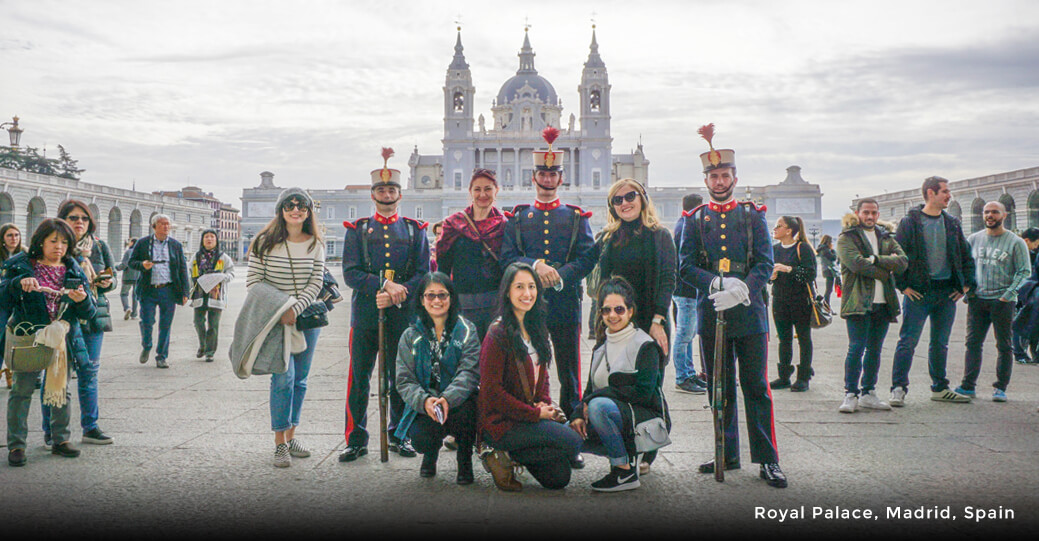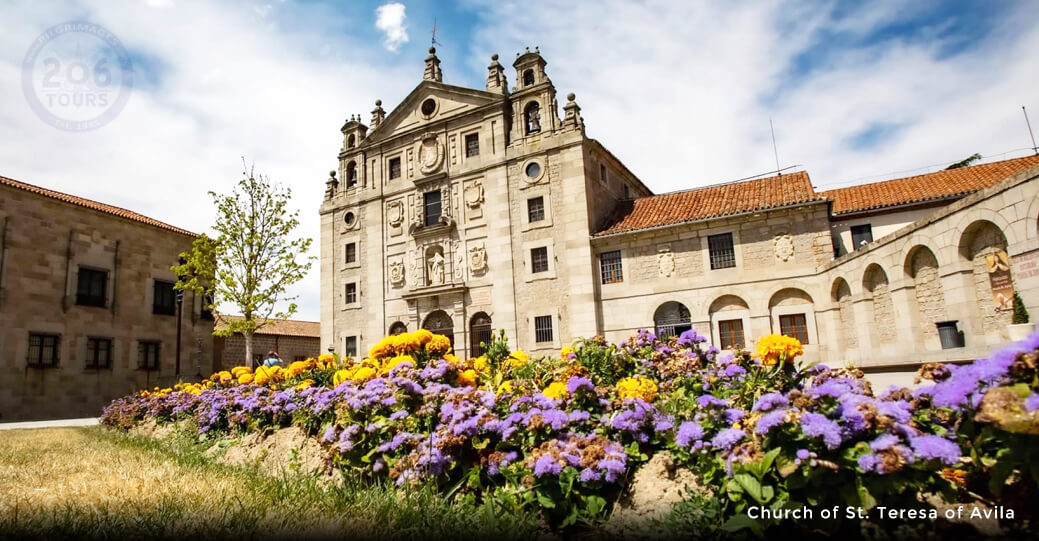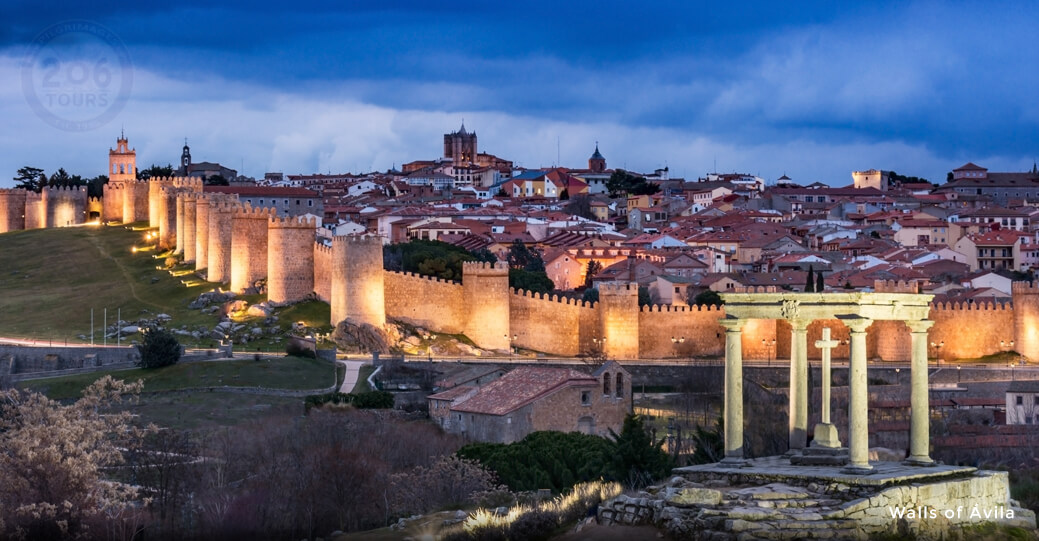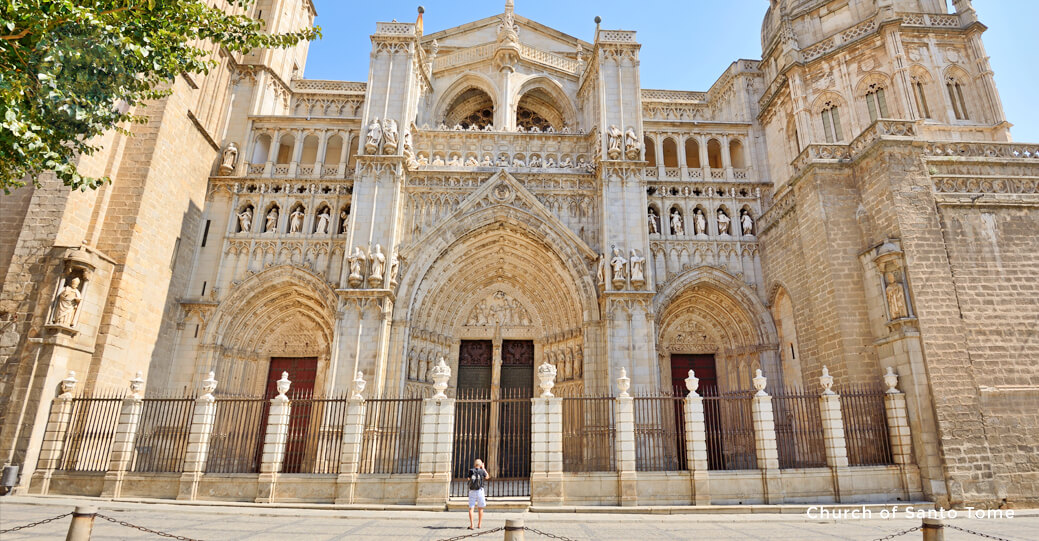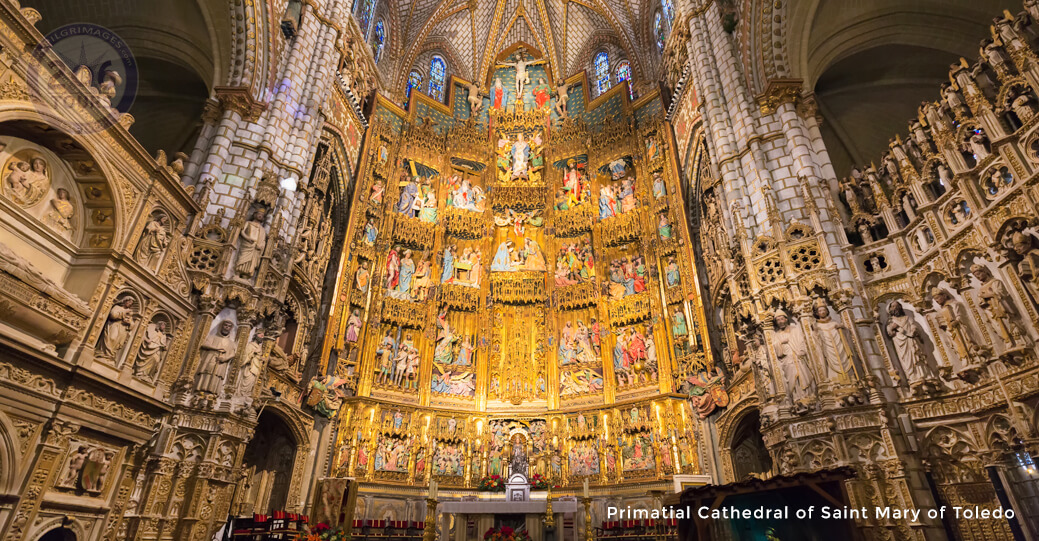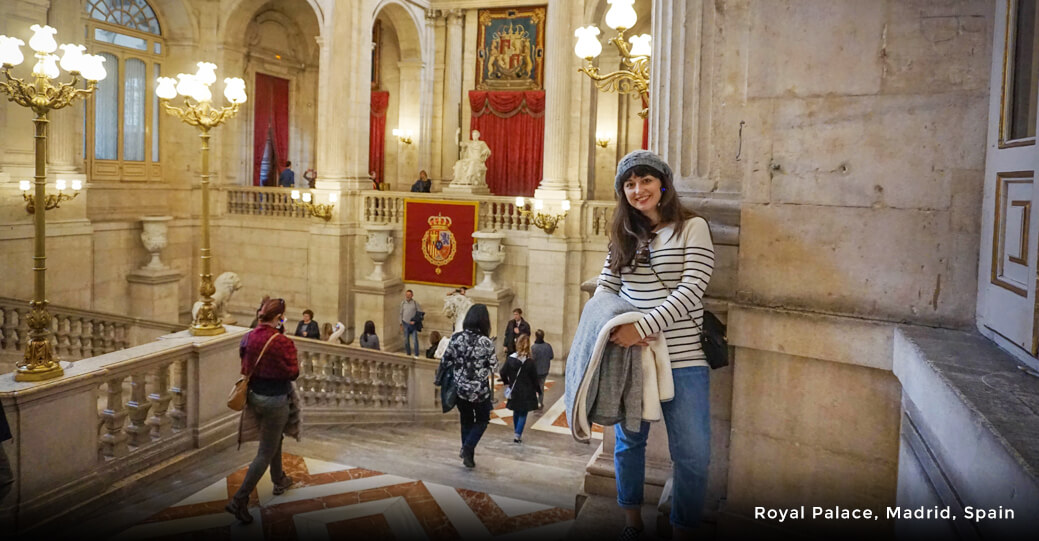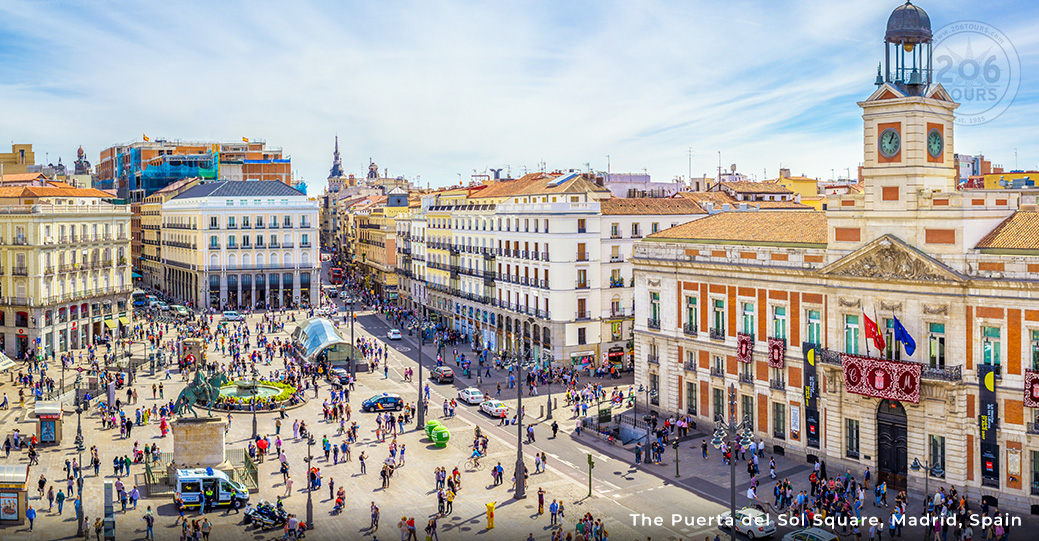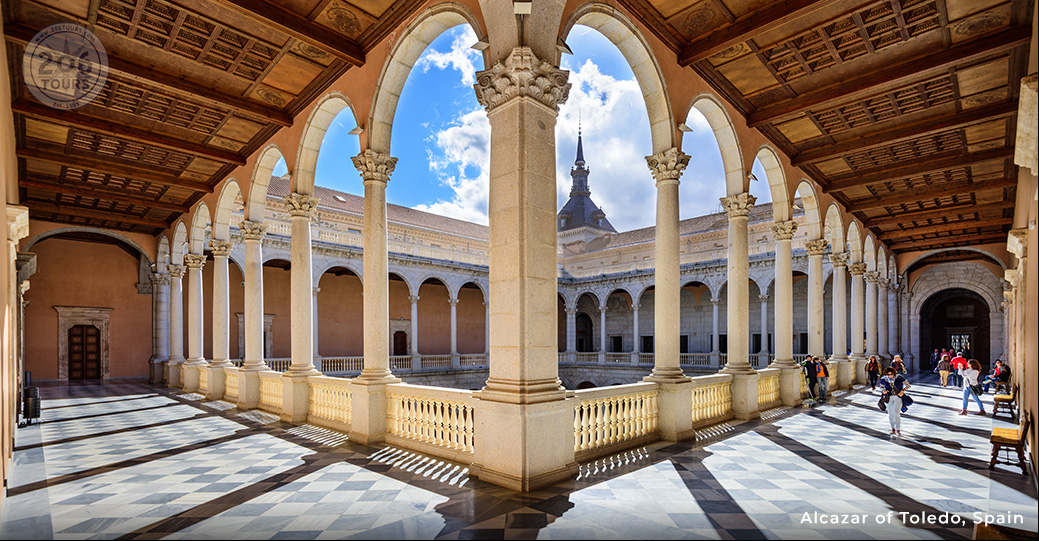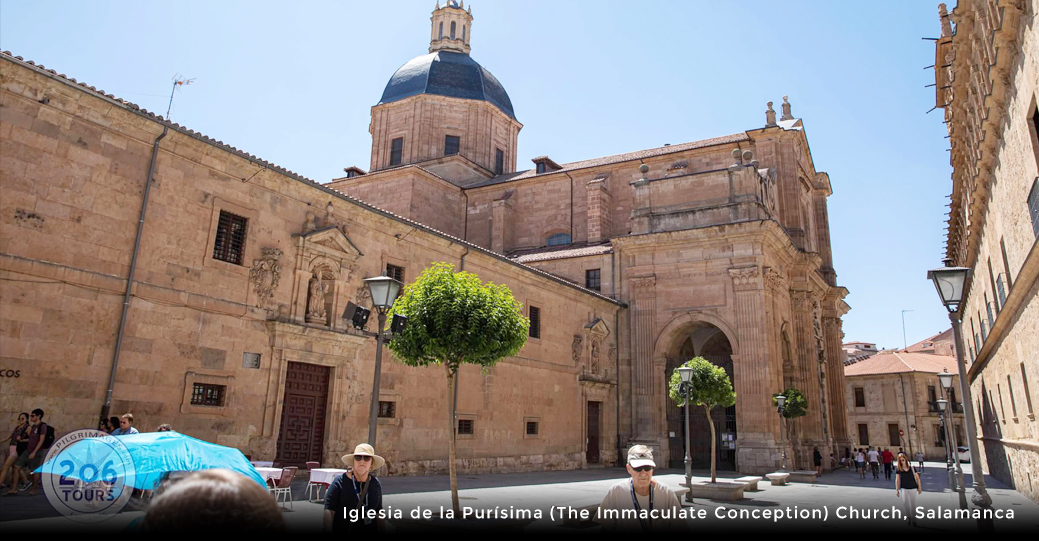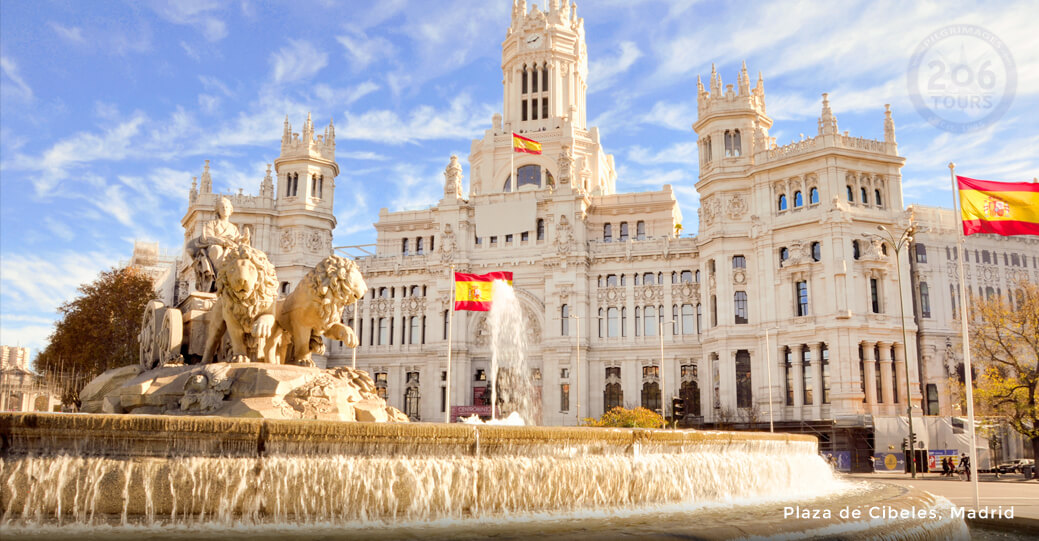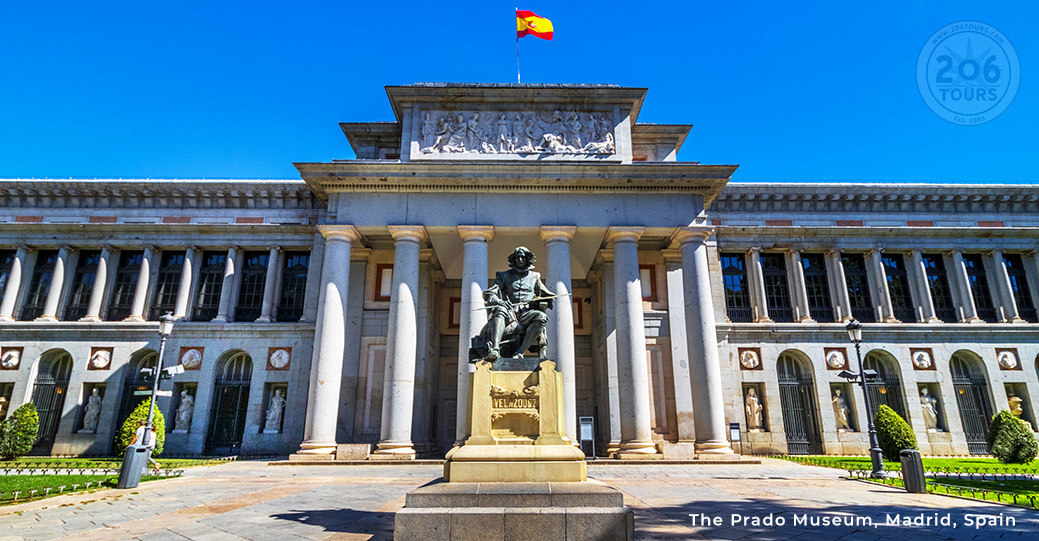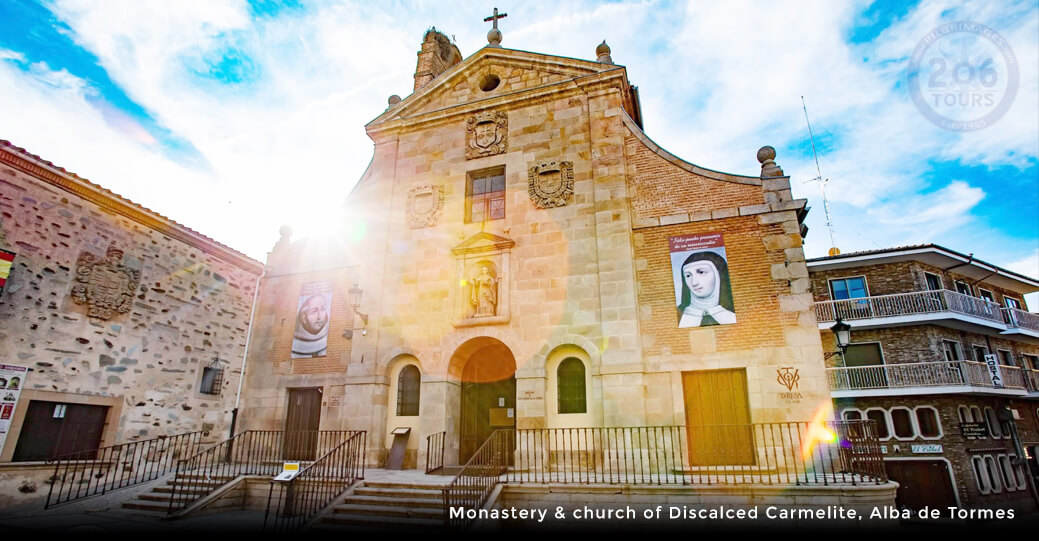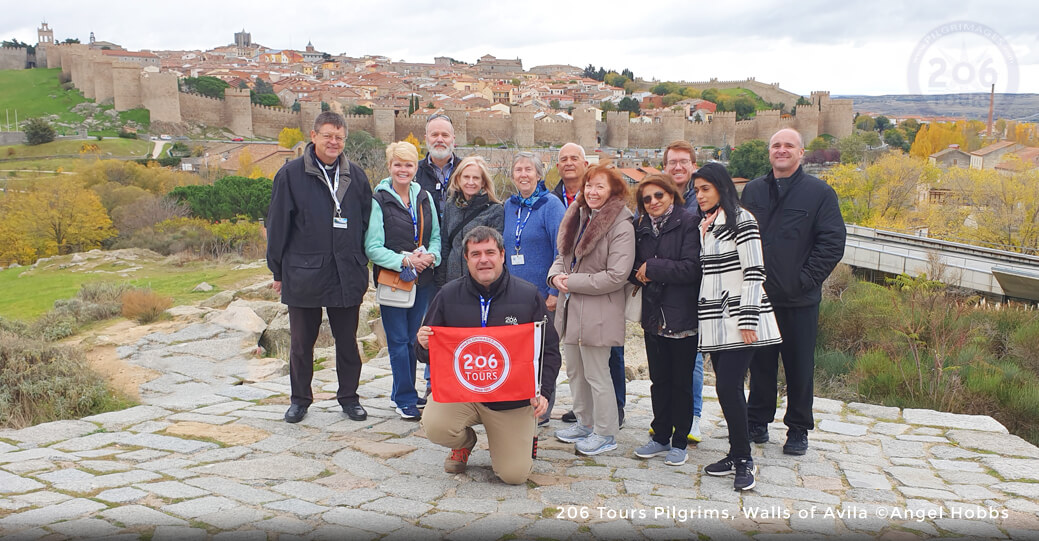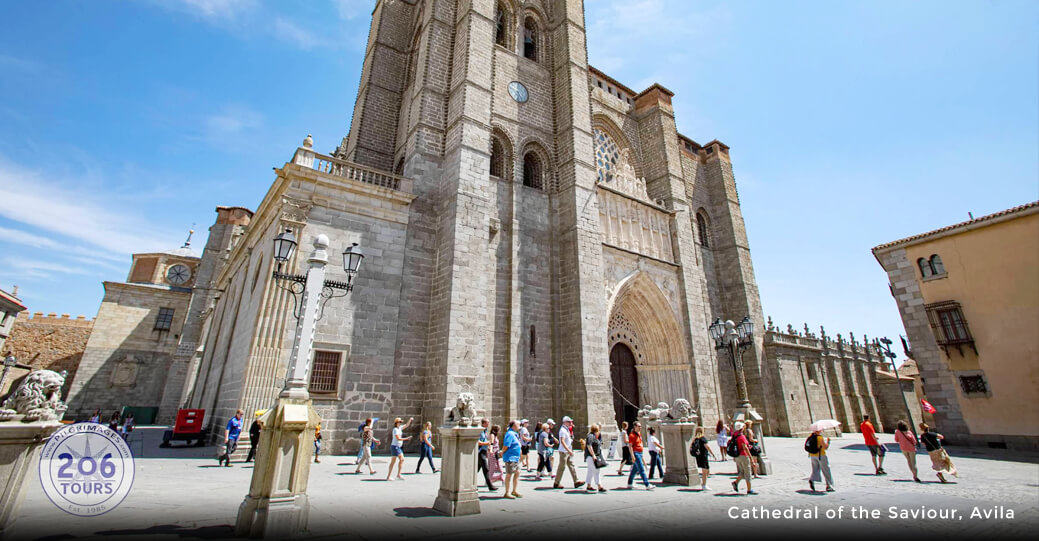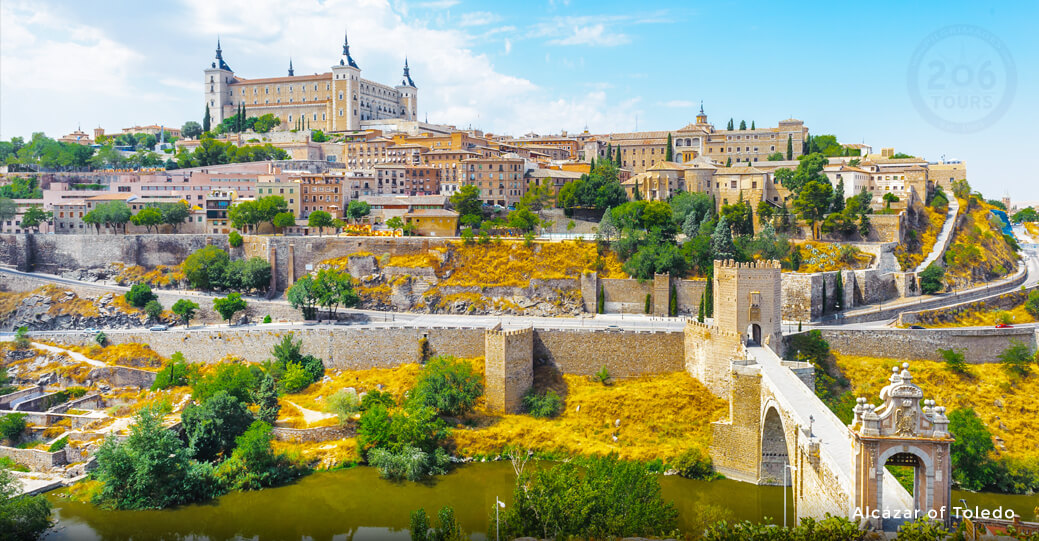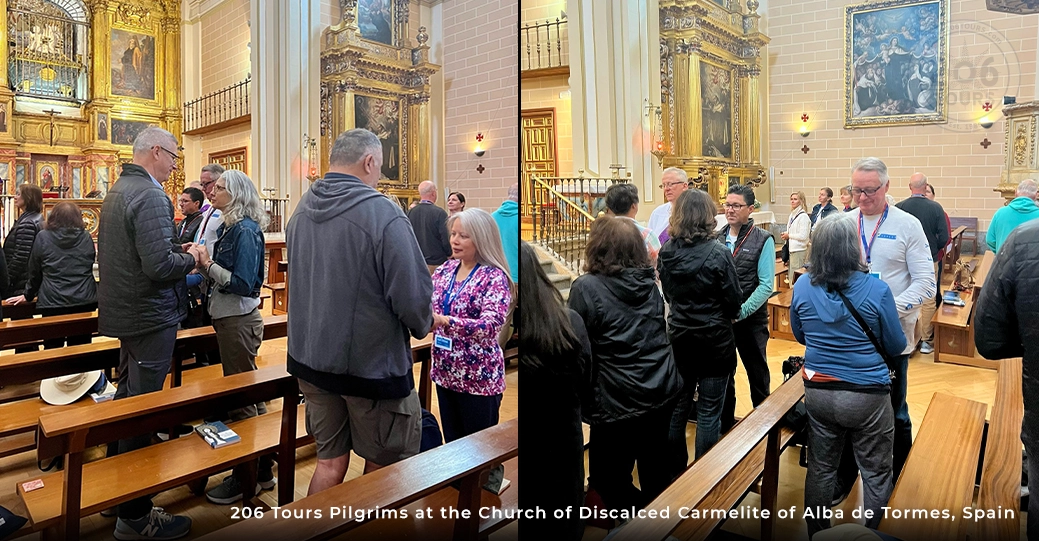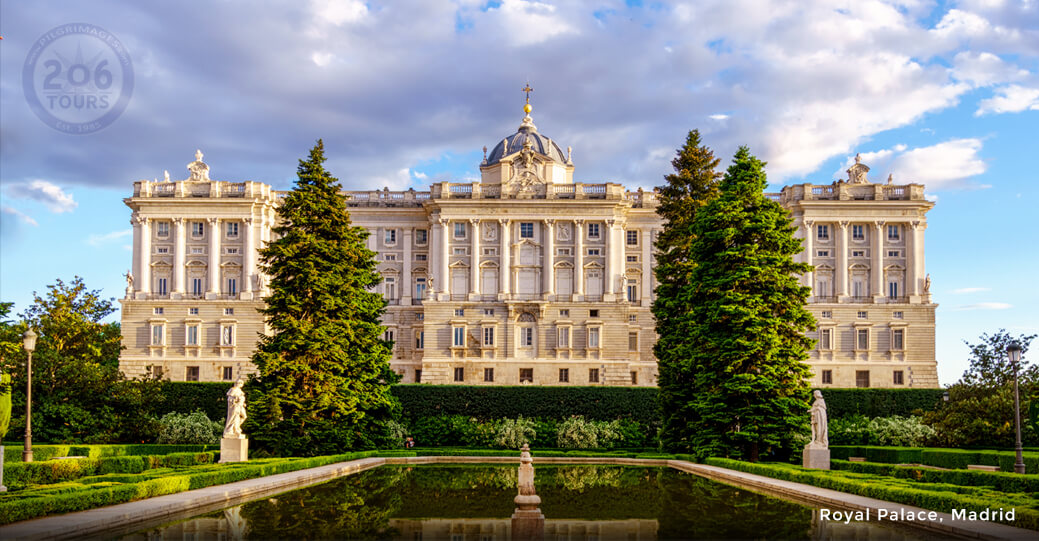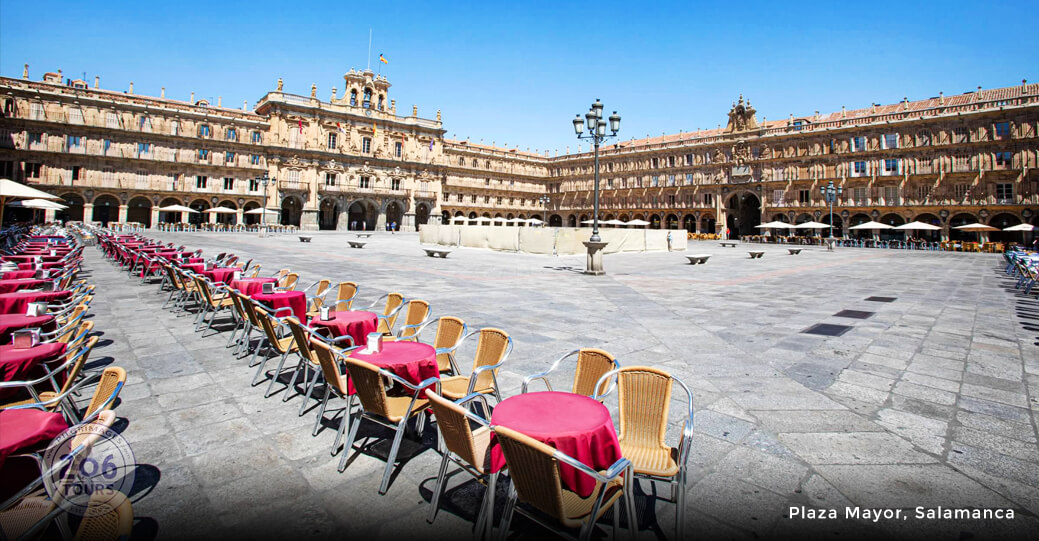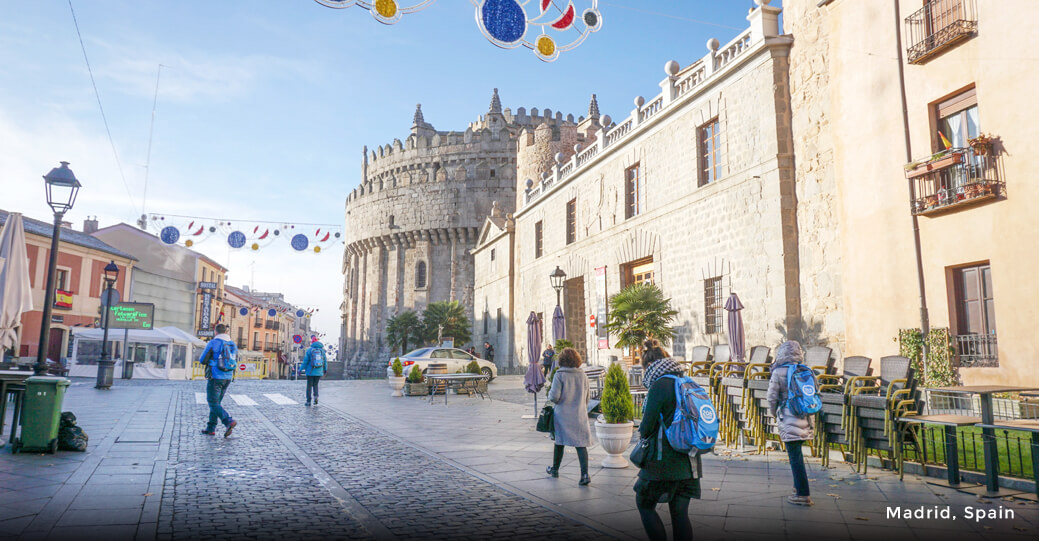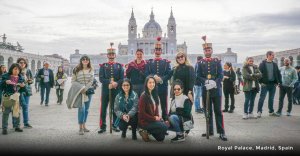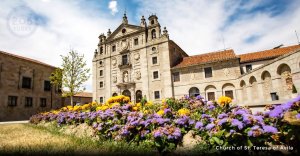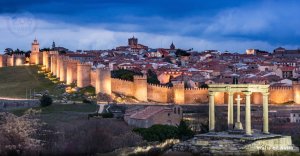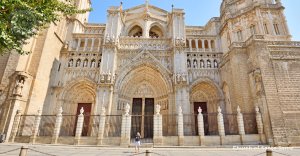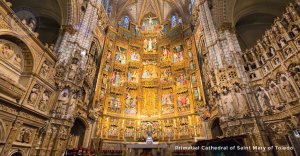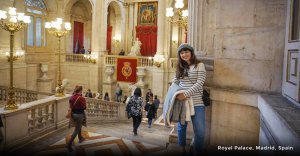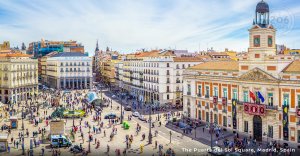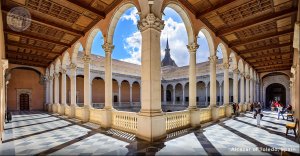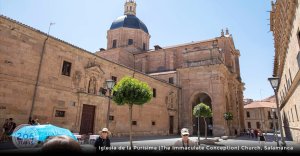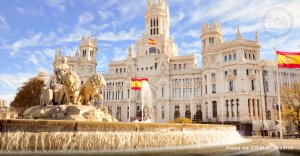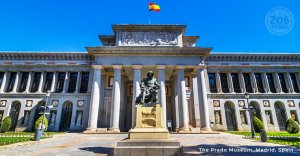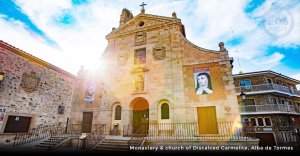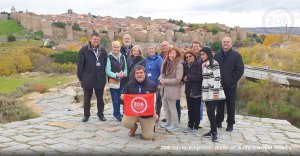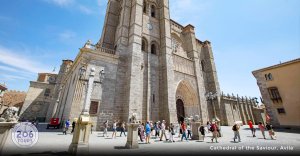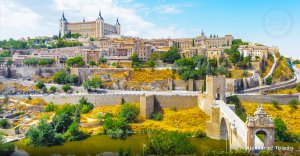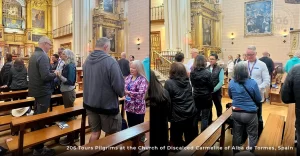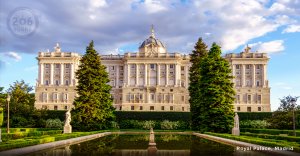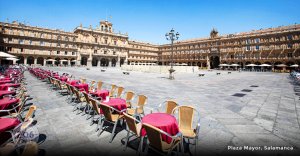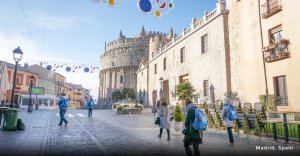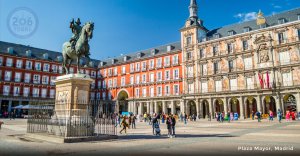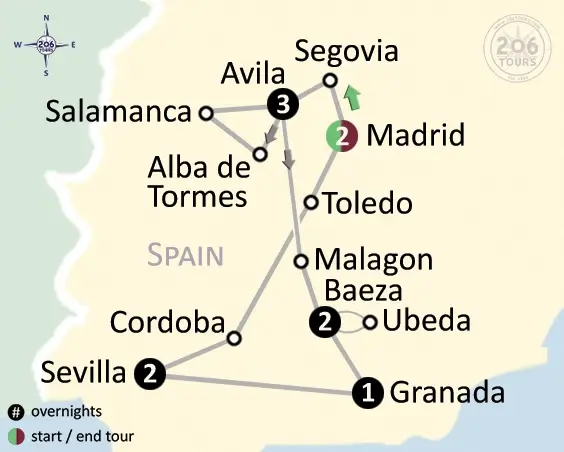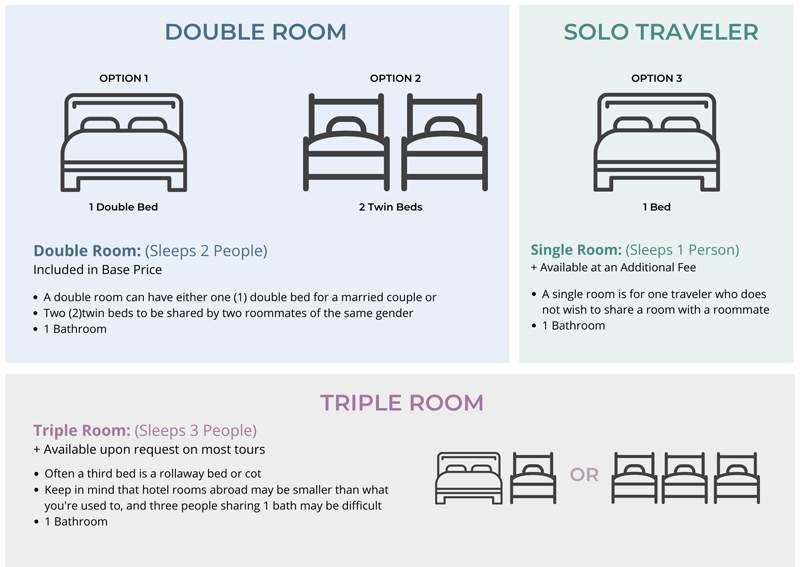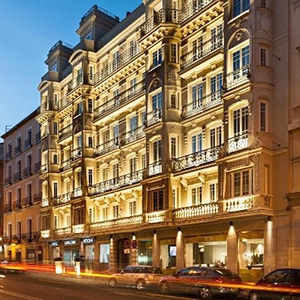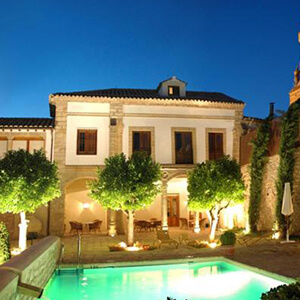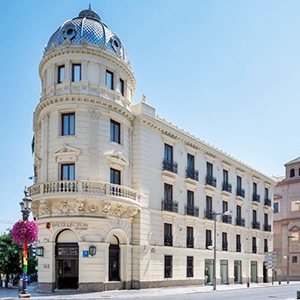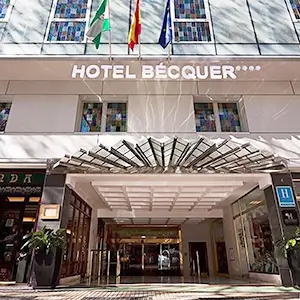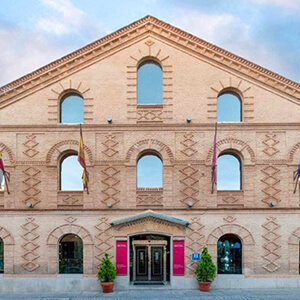Your trip includes
- Round-trip airfare from your desired Airport
- Prepaid seat assignments
- All airport taxes & fuel surcharges
- Catholic Priest
- Mass daily & Spiritual activities
- Hotel accommodations: (or similar) in double occupancy
- ~ 1 night: Catalonia Atocha, Madrid, Spain
- ~ 3 nights: Hotel Palacio de los Velada, Avila, Spain
- ~ 2 nights: Hotel Puerta de la Luna, Baeza, Spain
- ~ 1 night: NH Collection Granada Victoria, Granada, Spain
- ~ 2 nights: Hotel Bécquer, Seville, Spain
- ~ 1 night: Hotel San Juan de los Reyes, Toledo, Spain
- ~ 1 night: Catalonia Atocha, Madrid, Spain
- Breakfast and Dinner daily
- Wine and mineral water with dinners
- Transportation by air-conditioned motor coach
- Free WiFi & Water on bus
- Assistance of local guide throughout
- Whisper headsets (where needed)
- Transfers as per itinerary
- Sightseeing and admissions fees as per itinerary
- Luggage handling (1 piece per person)
Not Included
- Lunches, Tips to your guide & driver
Itinerary
Day 1: Depart for Madrid
Make your way to your local airport where you will board your overnight flight(s). Your meals will be served on board.
Day 2: Madrid Airport – Madrid
Upon arrival in Madrid, you will collect your luggage in the baggage claim area and continue to the Arrivals Hall where you will be greeted by your tour guide and/or driver, then transfer and check in at the hotel. In the late afternoon, we will be able to attend Mass at the first foundation of Santa Teresa, The Convent of Saint Joseph. After Mass, there will be free time at leisure. The day will come to a close with dinner and a restful overnight in Madrid.
Day 3: Madrid – Segovia - Avila
After breakfast, we will depart for a visit to the town of Segovia. Segovia is the town where Saint John of the Cross was buried. Segovia is a relatively small city strategically situated on a rock ridge. It is deeply and haughtily Castilian, with a panoply of squares and mansions from its days of Golden Age grandeur – it was once a royal resort and a base for the Cortes (parliament). It was in Segovia that Isabel La Católica was proclaimed queen of Castilla. We will find numerous impressive monuments and buildings inside its medieval walls, including the Roman aqueduct: Segovia Acueducto. It was built at the end of the first century during the reigns of the Emperors Nerva and Trajan. Over 800m long, it is supported by 166 arches and 120 pillars and stands up without a drop of mortar or cement. You will also see the Cathedral, the last major Gothic building in Spain; the Alcázar, an extraordinary fantasy castle, with its narrow towers and flurry of turrets; the Vera Cruz church, built by the Templar Knights; the synagogue, very similar in style to Santa María la Blanca in Toledo; and many Romanesque churches such as San Millán, San Justo, San Martín, and more. Continue to Avila for a delicious dinner and a restful overnight.
Day 4: Avila
After breakfast, we will visit the city of Avila. Here the atmosphere has changed very little since the days of St. Teresa, to whom the city is dedicated. St. Teresa was a great mystic and was the first woman to be named a Doctor of the Church. while in Avila we will visit: the crypt of La Santa Convent, built on the site of the house where she was born; La Encarnacion Convent, where St. Teresa became a nun and home to the most comprehensive museum dedicated to her life; and the Cathedral and the Cuatro Postes (four columns) which commemorates St. Teresa. At the age of seven, she convinced her brother to run away with her to die as martyrs in the land of the Moors. Their uncle caught them at this site and returned them home. The day will end with dinner and an overnight in Avila.
Day 5: Avila – Alba de Tormes – Salamanca – Avila
The day will begin with breakfast in the hotel. In the morning we will do an excursion to the surroundings of Avila including a visit to the town of Alba de Tormes and the city of Salamanca. Alba de Tormes is where St. Teresa died in 1582 and where she is buried. In the museum of the Carmelite Convent of the Annunciation, we will be able to see the incorrupt heart and left arm of the Saint. It was in Salamanca that Saint John of the Cross studied Theology and was ordained priest and where Santa Teresa founded the Carmelite Convent in 1570. For four centuries Salamanca was the seat of one of the most prestigious universities in the world and, despite losing this reputation in the XVII Century, it has kept the unmistakable atmosphere of being a seat of learning. It is a small place, and it is given a gorgeous harmony by the golden sandstone of which almost the entire city seems to be constructed. The city’s architectural sights seem endless: two cathedrals – one Gothic, the other Romanesque – vie for attention with Renaissance palaces and gems of Plateresque decoration. The Plaza Mayor is the finest in Spain, and the surviving university buildings are tremendous throughout – all of them distinguished by the same warm stone. Today we will visit this impressive and beautiful city. The grand Plaza Mayor is the hub of Salmantine life with the vast Baroque church of La Clerecía, the Casa de las Conchas (House of Shells, named after the rows of carved scallop shells symbol of the pilgrimage to Santiago which decorate its façade), the University, the cathedrals, the Roman Bridge, San Marcos, San Martin churches, and much more. We will wrap up the day with dinner and an overnight stay in Avila.
Day 6: Avila - Malagon – Baeza
We will begin the day with breakfast in the hotel, and then we will depart towards the South of Spain. On our way to Baeza, we will make stop in Malagon where we will find the Carmelite Convent founded by Santa Teresa in April 1568. We will continue on to Baeza for a delicious dinner and a restful overnight.
Day 7: Baeza – Ubeda - Baeza
The day will begin with breakfast in the hotel. We will spend the day visiting different places related to both Saints. In Baeza Saint John of the Cross worked like a teacher in its famous university, and in 1591 he died in Ubeda. Both cities, designated World Heritage sites by UNESCO, preserve magnificent buildings and monuments in their medieval and renaissance quarters: Incarnation Convent, Jabalquinto Palace, San Pablo Church, the Cathedral, Salvador Church, Santa Maria Church, and more. In Beas de Segura we will find the first convent founded by Saint Teresa in Andalucia (South of Spain) that holds many relics of both doctors of the Church. In Villanueva del Arzobispo we will visit the Sanctuary of La Fuensanta where Saint John of the Cross lived after running away from Toledo’s jail, helped by Saint Teresa. Return to Baeza for a delicious dinner and a restful overnight.
Day 8: Baeza – Granada
Our day will begin with breakfast in the hotel before departing toward Granada. Saint John of the Cross was Prior in Granada for many years and we will be able to follow in his steps in the city. In the afternoon we will visit one of the most beautiful palaces in the World: The Alhambra Palace. The meaning of the word Alhambra is “the red fort” and comes from its reddish walls. The Alhambra was a palace, a citadel, a fortress, and the home of the Nasrid sultans, high government officials, servants of the court, and elite soldiers (from the 13th to the 14th century). Today, the monument is divided into four main areas: the Palaces, the military zone of Alcazaba, the city of Medina, and the agricultural estate of the Generalife. Beautiful woods, gardens, and orchards surround all of these areas. Other notable buildings belonging to a different period are also included, such as the Renaissance-style Palace of Charles V, which houses the Alhambra Museum (most of the items are from the site of the monument) and the Fine Art Museum. In the evening we will enjoy a beautiful view of the Alhambra from the San Nicholas viewpoint. The day will come to a close with dinner and an overnight in Granada.
Day 9: Granada – Sevilla
Following an early breakfast, we will continue with the visit to downtown Granada where will we find the Cathedral and its Royal Chapel where the Catholic Monarchs Isabella and Ferdinand are buried. In the afternoon we will depart toward the city of Seville. Seville has important monuments and an illustrious history, but it’s essentially famous for its living self, the greatest city of the Spanish South, of Carmen, Don Juan, and Figaro, and the archetype of Andalucian promise. This reputation for gaiety and brilliance, for theatrically and intensity of life, does seem deserved. The city is bisected by the Río Guadalquivir. The old city takes up the east bank and at its heart stand three great monuments: the Giralda Tower, the minaret of the old mosque; the Cathedral, built in the XV Century in Gothic style; and the Alcázar, the Moorish palaces. We will also find the Barrio de Santa Cruz, the medieval Jewish quarter, and now the heart of tourist life. The day will end with dinner and an overnight stay in Seville.
Day 10: Sevilla
We will begin the day with breakfast in the hotel. Today we will enjoy a half-day tour of Seville, the capital of Andalucia, and the site of the Cathedral of Saint Mary, the largest Cathedral in Spain and the third largest in Christendom. It is here where Santa Teresa established her 11th foundation in 1575, and it is in the Carmelite Convent of Saint Joseph that the original autographed copy of Saint Teresa’s Interior Castle is kept. The day will come to a close with dinner and an overnight in Seville.
Day 11: Sevilla – Cordoba – Toledo
The day will begin with breakfast in the hotel, then we will board our bus and make our way towards Madrid. On the way, we will visit Cordoba. The city of Córdoba lies upstream from Sevilla beside a loop of the Guadalquivir River, which was once navigable as far as here. Today it is a minor provincial capital, prosperous in a modest sort of way. Once, however, it was the largest city of Roman Spain, and for three centuries it formed the heart of the western Islamic Empire, the great medieval caliphate of the Moors. It is from this era that the city’s major monument dates: the Mezquita-Catedral (Mosque-Cathedral) – the grandest and most beautiful mosque ever constructed by the Moors in Spain. It stands right in the center of the city, surrounded by the old Jewish and Moorish quarters, and is a building of extraordinary mystical and aesthetic power. Apart from the Mezquita, we will walk through the Jewish quarter and visit its synagogue. the day will come to a close with dinner and an overnight in Toledo.
Day 12: Toledo - Madrid
Following breakfast, we will visit the Imperial City of Toledo where Saint John of the Cross was imprisoned by the Inquisition. Toledo sits on a rocky mound isolated on three sides by a looping gorge of the Río Tajo. Every available inch of this outcrop has been built upon: churches, synagogues, mosques, and houses are heaped upon one another in a haphazard spiral which the cobbled lanes infiltrate as best they can. Toledo is known as the City of the Three Religions or Cultures because for many centuries the Christians, the Moors, and the Jews lived together in relative equality and peace. The city, surrounded by walls, hides great treasures: its awesome Cathedral, robust Gothic construction which took over 250 years (1227 – 1493) to complete; the church of Santo Tomé, where the Greco’s masterpiece is located – The Burial of Mr. Orgaz; the Tránsito Synagogue that houses the Museo Sefardita; Santa María La Blanca Synagogue; the superb church of San Juan de los Reyes, with its exterior bizarrely festooned with the chains worn by the Christians prisoners from Granada released on the reconquest of the city; the different doors that keep the city safe: Puerta de Bisagras, Puerta del Cambrón, Puerta del Sol; and more. After a full day, we will continue on to Madrid for a delicious dinner and a restful overnight.
Day 13: Madrid - Return Home
After breakfast, and with memories that will last a lifetime, we will board our bus that will bring us to the airport for our return flight home.
*206 Tours Disclaimer:
Occasionally local religious and national holidays, weather, traffic conditions and other events may necessitate changes in the sequence of events or the missing of certain events/places. Though every effort will be made to follow the itinerary, it should be considered as an indication, rather than a contract of events and places to be visited.

Special Clergy Discount
A Clergy Discount is available to all members of “Clergy” within the Catholic Church. This includes Seminarians, Deacons, Brothers and Sisters, Priests, Monsignors, Bishops, Cardinals, and His Holiness.

Earn a Free Trip
For groups of 20 or more, you may choose your own departure and earn FREE trips.

